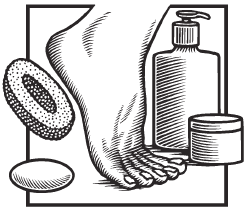 
|
|
|
Foot care
Info-sheet for seniors |
 |
Download
this document in PDF format
(4 pages, 137 KB) 
Table of Contents

Most people are born with healthy feet. But three out of four people develop serious foot problems as they age – putting their independence and well-being at risk. Healthy feet contribute to your safety and health. How?
-
Feet that are healthy and pain free help you keep your balance. Good balance can prevent falls, a major cause of injury and hospitalization; some falls result in disability or death.
-
Healthy feet also allow you to stay active. When your feet are too sore to walk, you lose strength and become at greater risk for falls. Walking is the perfect exercise to keep your weight down, prevent blood clots and keep your bones and muscles strong.
-
Keeping an eye on your feet can even give you an early warning about serious health problems such as diabetes, arthritis, nerve damage and poor blood circulation.

Warning signs
See your doctor or a foot specialist right away if you notice:
| • |
a sore on your foot that doesn't heal or gets infected |
| • |
pain when you walk that stops when you rest |
| • |
unusual coldness, cramps, numbness, tingling or discomfort in your feet |
| • |
that you are less sensitive to foot pain, hot or cold |
| • |
the skin on your feet or legs changes colour |
| • |
a change in the shape/structure of your foot |
|
Basic foot care
Foot pain may keep you from enjoying life and staying active. Many foot problems can be avoided if you:
-
Check your feet every day. Don't wait until your feet hurt. Take a few minutes every day to look for cuts, blisters, bruises, sores, infected toenails or swelling. Use a small mirror if bending over is a problem, or ask someone for help.
-
Wash your feet every day. Use warm water. Don't soak them longer than 10 minutes, or your skin will get dry and start to crack. Dry well between your toes.
-
Keep your feet soft and smooth. Use unscented cream on the tops and bottoms of your feet if the skin is dry and cracked.
-
Wipe off excess cream and don't apply between your toes. Use talcum powder if your feet sweat a lot.
-
Wear comfortable shoes and socks. Many people have foot problems because their shoes don't fit, don't give proper support or don't have enough grip on the ground.
Socks help keep your feet dry. Wear a clean pair every day. Avoid socks with ridges or an elastic at top; they can irritate or restrict circulation.
-
Be active every day. Walking is the best way to keep you, and your feet, healthy because you can do it anytime, anywhere – for free!
To increase circulation, prevent cramps and keep your muscles in good shape, try these exercises:
- while sitting, pick up marbles with your toes
- while holding onto a table or chair back, get up on your tiptoes, then rock back to your heels, 20 times
- while sitting, alternate pointing your toes toward your nose with pointing your toes downward; rotate your ankles in circles, first in one direction, then the other
- Take care of your toenails. Cut or file your nails regularly with appropriate nail care tools. Trim them straight across and never shorter than the end of your toe.

Shoes for health and safety
Here are some tips for buying shoes that protect your foot health:
-
Size. Have both of your feet measured every time you buy shoes. Since your feet may not be the same size, choose shoes that are 1/2 inch longer than your longest toe. Blisters, ulcers and bunions are often linked to shoes that are too small. Buy shoes late in the day as feet tend to swell.
| If
the shoe fits, buy it! |
-
Design. Don't let style alone guide your choice of shoes. The inside of the shoe should be soft with no inside seams or rough areas that can cause blisters or sores to form.
-
Material. Leather and canvas shoes are the best choices for letting your feet "breathe." They also bend with your foot, so won't rub and make blisters.
Tips for buying shoes that protect your safety include:
-
Design. Get shoes with closed toes and backs; they protect your feet from injury and provide support. The heel should be as wide as your foot, and no higher than 1.5 inches (3 cm), to keep your ankles from twisting and your back from aching. Running or walking shoes tend to be more comfortable and can make you more sure-footed.
-
Sole. Soles that provide grip are best.


Diabetes
and foot care
People with diabetes often have trouble with their feet. These problems are not just painful, they can be dangerous!
Diabetes can damage your nerves. If this happens, you might not feel hot, cold or pain in your feet. Little cuts or sores, if not cared for, can then become deeper and bigger sores called ulcers. This can be a very serious problem because diabetes can also cause poor blood flow in your legs. Without good blood flow, sores take longer to heal. If ulcers become infected, or foot tissue starts to die because of poor or no blood flow (gangrene), you may have to go to the hospital. In the worst cases, doctors may have to remove (amputate) toes, a foot or a leg.
Because diabetes may keep you from feeling foot problems, it is very important to:
- look at your feet every day to check for things like cuts, sores, ingrown or infected toenails, dry cracked skin or swelling
- wear shoes that fit well so you don't get blisters, corns or bunions on your feet
- ask your doctor to check your feet at each visit

Stay on your feet!
Wearing shoes is your best protection from falls. Research shows
that going shoeless indoors and out can increase your risk for falls
up to 10%. Each year about one-third of seniors are hurt in falls.
Their injuries include sprains and strains, broken bones or head
trauma. In Canada, more than 5,000 seniors die from falls each year.
|
Arthritis and foot care
Arthritis is a disease that affects joints. Since each foot has 26 bones and 33 joints, people with arthritis often suffer from sore and swollen feet.
Your doctor can treat many of the foot problems that are caused by arthritis as well as suggest medicine to relieve the pain.
Your choice of shoe can do a lot to keep your feet as comfortable as possible.
For example, your shoes should have:
- high, wide space at the toe
- rocker soles designed to reduce stress and pain at the ball of the foot
- laces that can be loosened if/when your feet swell

For more information...
-
Contact the Victorian Order of Nurses (VON), Public Health or local seniors centres for information on foot care services in your area.
-
To find a doctor who cares for feet, look under Podiatrist or Chiropodist in the Yellow pages.
-
To learn more about foot health, choosing shoes or how to prevent falls, visit these Web sites:
Victorian Order of Nurses (VON Canada)
www.von.ca  (Branch locations are noted on the home page) (Branch locations are noted on the home page)
Veterans Affairs Canada
www.vac-acc.gc.ca  (Type "foot care" in the search bar.) (Type "foot care" in the search bar.)
Canadian Diabetes Association
www.diabetes.ca/Section_About/feet.asp 
Diabetes Quebec
www.diabete.qc.ca/english/living_diabetes/html/footcare.html 
The Arthritis Society
www.arthritis.ca  (Type "foot care" in the search bar.) (Type "foot care" in the search bar.)
Ontario Podiatric Medical Association
www.opma.ca/press/?type=health&pa=right 
Public Health Agency of Canada
www.phac-aspc.gc.ca/seniors-aines
Canadian Orthopaedic Foundation
www.canorth.org 
Our thanks to VON Canada for its contribution to this Info-sheet.
Division of Aging and Seniors
Public Health Agency of Canada
This info-sheet is available in alternative formats on demand.
Cat.: H30-11/8-8E
ISBN: 0-662-39174-8
(Reprint, Nov. 2005)
|




